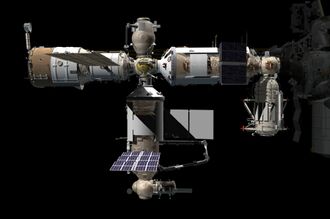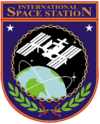Prichal (ISS module)
Topic: Engineering
 From HandWiki - Reading time: 9 min
From HandWiki - Reading time: 9 min
Template:Infobox space station module
Nodal module Prichal also known as Uzlovoy Module or UM (Russian: Узловой Модуль "Причал", Nodal Module Berth)[1] is a Russian spacecraft which will form part of the International Space Station (ISS). It was approved in 2011 and is scheduled for launch on 24 November 2021, with operations beginning in 2022.[2][3][4][5] Originally, the node module was intended to serve as the only permanent element of the future Orbital Piloted Assembly and Experiment Complex (OPSEK), but those plans were scrapped in 2017.[2][6]
History
Early launch targets
The Orbital Piloted Assembly and Experiment Complex (OPSEK), was a proposed Russian space station, intended to support deep space human exploration missions to Mars, possibly the Moon, and Saturn. It was planned to be partially constructed in orbit, while attached to the ISS. Prichal, with its six docking ports, would have served as the only permanent element of OPSEK, while other modules would come and go as their life span and mission required.[2][7] In September 2017, Roscosmos stated that there "no plans to separate the Russian segment from the ISS". This ended public OPSEK plans.[8]
Launch delays
In the mid-2000s, RKK Energia, the manufacturer of the Russian Orbital Segment (ROS) components, added the Uzlovoy Module (UM) to the future configuration of the ISS. The proposal involves the addition of a Nodal Module (a significant modification of the Universal Docking Module (UDM) design, increasing the number of docking ports from 4 to 6 and taking into account its location at the Nauka nadir and at the same reducing its weight from 20 tons to 4 tons, partly by removing the additional life-support system [9]) and adding two additional science/energy modules to the segment around 2013-2015. These plans were tabled, due to Nauka delays.[10] Since the refurbishment of the Nauka module, the Uzlovoy module is now the Prichal module.[5][11][12] Despite its small size, this four-ton, ball-shaped module could play an extremely important role in the Russian space program.[2]
The preliminary design was completed on 15 January 2011, when RKK Energia announced that its Scientific and Technical Council (NTS), conducted a meeting which reviewed and approved the preliminary design of the Nodal Module and associated hardware. The meeting also approved the specialized launch craft, a Progress cargo ship designated the Progress M-UM and the adaptation of the Soyuz rocket for the launch of the Progress M-UM spacecraft-module.[7][2]
Initially, the nodal module was expected to be incorporated into the ISS in 2012, but the launch has been postponed several times because of the delays with Nauka module, which should be launched prior to Prichal.[2] In November 2018, Executive Director for Manned Space Programs of Roscosmos Sergei Krikalev has claimed that Prichal is ready to fly, while there were still "little problems" with Nauka.[13]
At the control and test station of the Rocket and Space Corporation "Energia" S.P. Korolev (part of the Roscosmos State Corporation), technological tests of the Prichal nodal module as part of the Progress M-UM transport cargo vehicle-module have been completed. Today, 31 July 2021, the spacecraft went to the technical complex of the Baikonur cosmodrome to continue assembly and pre-flight preparation in accordance with the schedule for the further development of the Russian segment of the International Space Station.
In recent weeks, RSC Energia specialists have successfully completed a cycle of joint tests of the Prichal module with the integrated stands of the Zvezda service module and the Nauka multipurpose laboratory module on the territory of the KIS. After the final operations, the undocked components of the spacecraft and ground test equipment were prepared for shipment to the cosmodrome by rail.
The launch of the Prichal nodal module into low-earth orbit as part of the Progress M-UM transport cargo vehicle-module using the Soyuz-2.1b launch vehicle is planned for November 2021.[14]
Processing at Baikonur
On 11 August 2021, Prichal arrived at Baikonur after a four day train ride from Energia in Moscow with its service module, Progress M-UM. The module was extracted from its container and placed in the hard stand that previously held Nauka while the propulsion module was moved over to Soyuz Test Stand 2 in hall 104 at Site 254. On the same day, specialists from RKK Energia installed the module and its progress in their respective processing rigs at Site 254 and began setting up the automated test network of the processing complex. As part of incoming inspection procedure, specialists conducted visual inspection of the propulsion module of Progress M-UM, and performed testing of the solar panel deployment mechanism on the vehicle. Over the next few months Prichal will be checked out before the module is placed in a fairing and attached to a Soyuz 2.1b rocket for delivery to the station.[15]
On 20 September 2021, Prichal was transferred to the vacuum chamber and testing is now under way. During the test Prichal will be filled with compressed helium to check the hatches for leaks. Once testing is complete the wiring will be installed and Prichal will be returned to the vacuum for its pneumatic test in October.[16]
Planned launch

Prichal is scheduled to be launched on 24 November 2021, on the Progress M-UM spacecraft; a modified Progress spacecraft which will be used to deliver it to the space station.[2] A Soyuz-2.1b carrier rocket will be used to place it into orbit.[2] The nodal module will be docked to the re-configured nadir, or Earth-facing port of the Nauka module after removal of the module's nadir docking adapter by Progress MS-17,[2] whose launch is planned for 24 November 2021. It is because Prichal, though is the second module after Rassvet to use a port initially used by soyuz or Progress spacecrafts, it is not able to dock to SSVP ports like Rassvet module. So the port is reconfigured by Progress MS-17 before Prichal docking.[needs update][citation needed]
Design
The nodal module has a ball-shaped design with six hybrid docking ports. One port is active to allow docking with the space station, while the remaining five ports are passive, enabling other spacecraft to dock with the module.[2] Such a design is significantly different from the one of the docking modules Pirs and Poisk that have only one docking port for spacecraft each. Additionally, the port opposite to the active one would support automated transfer of propellants between docked Russian spacecraft and the space station in both directions, and automated docking of crewed and uncrewed spacecraft using the Kurs system.[5] The docking compartment has an internal volume of 14 cubic metres.[2]
Usage on the International Space Station
Prichal is planned to be docked to the Nauka module, launched on 21 July 2021. Nauka has attached to the nadir port of the Zvezda module, replacing the Pirs docking module, and the plan is to dock Prichal to the nadir port of Nauka.[17] Such a placement would create enough separation from the Zvezda and Zarya ISS modules for the other five docking ports to be used freely by Soyuz and Progress spacecraft and for other modules, SPM-1 in particular.
Multi-docking compartment
In the future, it will be standard practice to dock Soyuz vehicles to the nadir ports of Rassvet and Prichal and dock Progresses to the aft port of Zvezda and the zenith port of Poisk. This is because the transfer chamber which connects to Zvezda’s aft port has a small leak which requires the hatches to remain closed as much as possible, which would block access to a Soyuz if it were docked to Zvezda's aft port. In addition, Progress crafts are preferred for the aft port as this enables them to perform ISS reboosts using their main engines. Progresses are also preferred for the Poisk zenith port as Poisk is now serving as the Russian Segment's airlock following the departure of Pirs, and access to Soyuz craft docked to Poisk is blocked whilst Poisk is depressurized during spacewalks, which presents safety issues in an ISS evacuation scenario.[18]
See also
- Orbital Piloted Assembly and Experiment Complex - proposed complex (scrapped in September 2017)
- Universal Docking Module - the original proposal that eventually became Prichal
References
- ↑ "В РКК "Энергия" утвердили эскиз нового узлового модуля МКС". Roskosmos. http://www.federalspace.ru/main.php?id=2&nid=14689.
- ↑ 2.00 2.01 2.02 2.03 2.04 2.05 2.06 2.07 2.08 2.09 2.10 Zak, Anatoly (22 June 2020). "Prichal Node Module, UM". RussianSpaceWeb. http://www.russianspaceweb.com/iss_node.html#2020.
- ↑ Sohail, Daniyal (20 February 2019). "Russia To Install Prichal Node Module On ISS In 2022, One Year Behind Schedule - Glavkosmos". UrduPoint. https://www.urdupoint.com/en/technology/russia-to-install-prichal-node-module-on-iss-556136.html.
- ↑ "Строительство российского сегмента МКС завершится в 2022 году" (in Russian). RIA Novosti. 19 November 2018. https://ria.ru/space/20181119/1533093337.html.
- ↑ 5.0 5.1 5.2 Atkinson, Ian (19 August 2020). "Russia's Nauka Arrives Baikonur for final launch preparations". NASASpaceFlight.com. https://www.nasaspaceflight.com/2020/08/nauka-arrives-baikonur-final-preps/.
- ↑ [1] Energia.ru (13 January 2011) Retrieved 8 October 2011
- ↑ 7.0 7.1 "January 13, 2011. S.P. Korolev RSC Energia, Korolev, Moscow Region". S.P. Korolev Rocket and Space Corporation Energia. 13 January 2011. http://www.energia.ru/en/news/news-2011/news_01-13.html.
- ↑ Bodner, Matthew (24 July 2017). "Russia's Post ISS plans a Mystery at Best". SpaceNews. https://spacenews.com/russias-post-iss-plans-a-mystery-at-best/.
- ↑ Zak, Anatoly. "Russian segment of ISS". RussianSpaceWeb. http://www.russianspaceweb.com/iss_russia.html.
- ↑ Zak, Anatoly (22 March 2017). "This Russian ISS Module Has Been Delayed For a Decade and It's Still Not Ready to Fly". Popular Mechanics. https://www.popularmechanics.com/space/satellites/a25773/mlm-delayed-russia/.
- ↑ "Russia Needs Billions More To Complete It's [sic] ISS Segment". Space-Travel.com. 14 April 2008. http://www.space-travel.com/reports/Russia_Needs_Billions_More_To_Complete_Its_ISS_Segment_999.html.
- ↑ Shamsutdinov, Sergei (July 2008). "Program for Development of the Russian ISS Segment" (in Russian). Novosti Kosmonavtiki. http://www.novosti-kosmonavtiki.ru/content/numbers/306/index.shtml.
- ↑ Kaiyran, Denis (19 November 2018). "Сергей Крикалев: к экипажу из шести человек МКС вернется в апреле" (in ru). RIA Novosti. https://ria.ru/interview/20181119/1532959857.html.
- ↑ "Новости. Узловой модуль «Причал» отправился на Байконур". https://www.roscosmos.ru/32057/.
- ↑ "Новости. Модуль «Причал» на техническом комплексе космодрома Байконур". https://www.roscosmos.ru/32159/.
- ↑ "S.P. Korolev RSC Energia - News - Vacuum Tests of Node Module Prichal began at the Baikonur Cosmodrome". https://www.energia.ru/en/news/news-2021/news_09-20.html.
- ↑ Zak, Anatoly. "The MLM module for the Russian segment of ISS". RussianSpaceWeb.com. http://www.russianspaceweb.com/iss_fgb2.html.
- ↑ Harding, Pete (2021-07-29). "MLM Nauka docks to ISS, malfunctions shortly thereafter". NASASpaceFlight.com. https://www.nasaspaceflight.com/2021/07/nauka-docking/.
External links
| Wikimedia Commons has media related to International Space Station. |
- NASA assembly sequence – Updated 8 December 2006
- Space Events diary July-September 2001.pdf – There is a paragraph stating the UDM was cancelled and to be replaced with the 70% complete FGB-2, with modifications
- FGB-2 module – An article written on 10 August 2001, discussing the plans for UDM and FGB-2
- Prichal Node Module, UM - An Article for Prichal Module
Space agency websites
![]() Russia (Energia)
Russia (Energia)![]() Russia (Federal)
Russia (Federal)
 KSF
KSF



